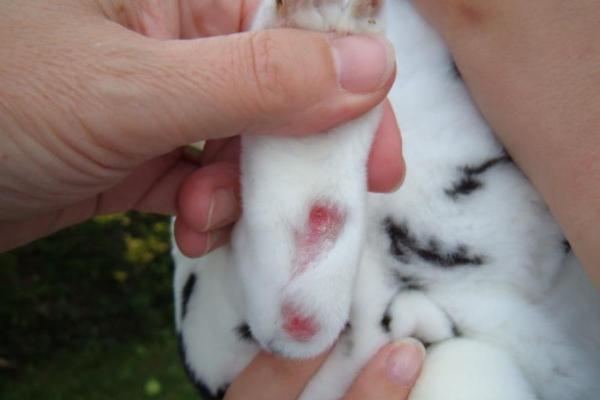What Is Pododermatitis in Rabbits?



See files for Rabbits
Pododermatitis, commonly referred to as Fur Pad Dermatitis (FPD), is a condition that affects rabbits, primarily manifesting in the sensitive paw pads on their feet. This ailment is characterized by inflammation and dermatitis, often stemming from a combination of factors such as pressure, poor bedding, hygiene, and breed disposition. As caring rabbit enthusiasts, understanding the nuances of pododermatitis is crucial for maintaining the health and well-being of our furry companions.
In the following AnimalWised article, we explain what pododermatitis or FPD in rabbits is. We also explore its symptoms, treatment options, and preventive measures.
What is pododermatitis in rabbits?
Pododermatitis, alternatively known as Fur Pad Dermatitis (FPD) in rabbits, signifies a chronic and gradually advancing condition that predominantly targets the plantar area of their feet—more colloquially recognized as the bottom or paw pads.
This affliction evolves as a result of multiple contributing factors that collectively elevate pressure on the metatarsal region. This heightened pressure, in turn, sets the stage for a succession of adverse outcomes affecting the delicate tissues in this specific area.
In response to this heightened pressure, the affected tissues go through a series of events. Inflammation, lack of proper blood supply (ischemia), and tissue death (necrosis) occur within the plantar region.
This progression gives rise to a range of dermatological issues, starting with the thickening of the skin known as hyperkeratosis. Following this, erosions—essentially abrasions or damage to the skin—occur. The most visible manifestation of this condition is the development of open wounds called ulcers.
One of the complications associated with pododermatitis is the susceptibility of these ulcers to infection by harmful microorganisms like Staphylococcus aureus, Streptococcus, or Pasteurella. These bacterial interlopers can further worsen the situation, potentially leading to deeper tissue involvement and spreading the infection to adjacent areas. This can result in joint problems such as arthritis and synovitis, tendon issues like tendinitis, and even bone infections called osteomyelitis.
In severe cases, the infection can extend to the bloodstream, causing a serious condition known as sepsis, which can have life-threatening consequences.
Symptoms of pododermatitis in rabbits
The progression of clinical signs in FPD unfolds sequentially, prompting the classification of the disease into various degrees based on the severity of the lesions. The following categorization helps us understand the evolution of this disease:
- GRADE 0: at this stage, no discernible lesions are present in the plantar area of the metatarsus. The feet appear unaffected.
- GRADE 1: characterized by a small circular region on the plantar metatarsal area, this stage exhibits minimal hair loss (alopecia), slight redness, and a modest thickening of the skin (hyperkeratosis). No signs of infection or bleeding are evident.
- GRADE 2: the condition progresses to an area of variable size on the plantar metatarsal region, showing signs of hair loss, increased redness, and peeling of the surrounding tissues.
- GRADE 3: in this phase, an ulcerated area of variable dimensions becomes apparent, featuring an open wound. Additionally, there's evidence of infection in the subcutaneous tissue beneath the skin.
- GRADE 4: at this juncture, there's a complete loss of skin in the affected region, accompanied by necrotic tissue debris (dead skin). The infection extends into the subcutaneous tissue, with purulent exudates possibly adhering to the lesions.
- GRADE 5: this stage involves a severe infection that reaches into deeper structures such as bones, joints, and/or tendons. The complications have become more intricate and profound.
- GRADE 6: the final stage marks a loss of limb functionality. The condition has advanced to a point where the rabbit's ability to use the affected limb is severely compromised.
The importance of timely detection and intervention cannot be overstated, as the condition may appear innocuous initially but can escalate into a serious concern with broader implications for the rabbit's health and well-being.
You might find this related article interesting, as we delve into the reasons behind your rabbit's fur loss.

Causes of pododermatitis in rabbits
As previously discussed, FPD is a condition that arises from the convergence of various contributing factors. Among these factors, the following play pivotal roles in its development:
- Inadequate accommodation: FPD can arise when rabbits are kept in environments with overly abrasive bedding or substrates. The constant contact with such surfaces can lead to erosion of the skin on their extremities.
- Hygiene and humidity: the presence of unclean living conditions and excessive substrate humidity creates an environment conducive to the growth of harmful microorganisms. These microbes can exacerbate the development of FPD.
- Elevated body condition: obesity in rabbits increases the risk of FPD. The excess weight can put additional pressure on the feet, making them more susceptible to irritation and subsequent dermatitis.
- Inactivity: rabbits that are inactive due to other illnesses or prolonged confinement within a cage are more prone to FPD. Lack of movement can lead to prolonged contact with potentially abrasive surfaces.
- Breed predisposition: certain breeds, particularly giant rabbit breeds, are predisposed to a higher risk of developing FPD. Their larger size and weight might contribute to increased pressure on their feet, making them more susceptible to this condition.
Understanding the intricate interplay of these factors is crucial in managing and preventing FPD. By addressing these contributing factors, the likelihood of FPD occurrence can be reduced, promoting the overall well-being of rabbits.
Diagnosis of pododermatitis in rabbits
The diagnosis of pododermatitis in rabbits is typically a straightforward process, generally relying on two key components:
- Anamnesis: this involves a detailed conversation with the caregiver to glean insights into potential predisposing factors that may have contributed to the development of the dermatitis. Understanding the rabbit's living conditions, diet, physical activity, and any recent changes is crucial in this regard.
- Physical examination: a comprehensive physical examination of the rabbit is essential. This includes scrutinizing the limbs for lesions and conducting orthopedic and neurological evaluations. These assessments provide valuable information about the extent of limb functionality and the overall severity of the condition.
However, there are instances where additional tests are warranted to attain a more precise diagnosis. These include:
- Cytology: this test involves examining samples under a microscope to observe the inflammatory process and detect any potential presence of bacteria. It aids in confirming the presence of infection.
- Culture and antibiogram: this test is conducted to pinpoint the specific pathogenic agents involved and to determine their sensitivity to various antibiotics. This information guides effective treatment strategies.
- X-ray: X-rays are employed to assess whether the bones of the extremity are implicated. This is particularly relevant in understanding the full scope of the condition.
- Blood analysis: in severe cases, blood analysis may be necessary to evaluate the systemic involvement of the patient. This can provide insights into how extensively the condition has affected the rabbit's overall health.
By utilizing these diagnostic tools, veterinarians can gain a more comprehensive understanding of the condition, allowing for tailored treatment plans that address the specific needs and circumstances of the rabbit.
How to cure pododermatitis in rabbits?
The treatment approach for pododermatitis in rabbits is contingent upon the extent of limb involvement, ranging from simple management adjustments to potential surgical interventions. Here's a breakdown of the various treatment options:
- Handling: a fundamental aspect entails enhancing environmental conditions, such as providing a soft and comfortable substrate. Improved hygiene practices are essential. Moreover, dietary modifications should be implemented to address obesity concerns. Encouraging physical activity becomes pivotal in tackling weight issues.
- Antibiotherapy: treating the infection involves either topical or systemic administration of antibiotics. This approach targets the infection directly.
- Analgesia: pain management is essential. Adequate pain control measures are implemented to ensure the rabbit's comfort.
- Disinfection and lesion treatment: this step involves shaving the hair around the affected area, followed by disinfection using antiseptic agents. Removal of necrotic tissue is necessary. In early stages, specialized ointments or creams designed for rabbit FPD, containing ingredients like mupirocin, fusidic acid, and blastostimulin, can be employed. These products aid in maintaining skin hydration and integrity.
- Laser therapy: laser therapy is utilized to expedite healing and provide analgesia in the affected region. It contributes to a more rapid recovery.
- Surgery: in severe instances, surgical intervention becomes imperative. This entails thorough cleaning and debridement of the wound. Subsequently, padded dressings and bandages are applied to safeguard the extremity and facilitate the healing process.
Don't overlook this additional article that tackles the topic of abscesses in rabbits.
How to prevent pododermatitis in rabbits?
As we've delved into throughout this discussion, pododermatitis arises from a mix of factors tied to how rabbits are cared for and what they eat. The encouraging truth is that, in most cases, this issue can be prevented. So, how do we keep pododermatitis or FPD at bay for rabbits? It's all about avoiding the things that could make them more likely to develop it. The basic principles for steering clear of pododermatitis include:
- Preventing obesity: this involves providing rabbits with a well-rounded diet that includes 80% hay, 15% fresh vegetables, and 5% high-quality rabbit feed. Encouraging regular exercise and avoiding prolonged confinement within cages is pivotal in maintaining a healthy weight.
- Offering an appropriate environment: ensure that rabbits are not exposed to beds or abrasive substrates that could exacerbate the condition. Prioritize cleanliness and hygiene within the living environment.
- Regular veterinary visits: consistent veterinary check-ups play a crucial role in early detection. Identifying lesions at an early stage allows for timely intervention, leading to improved outcomes and averting the development of serious complications.
By conscientiously adhering to these foundational principles, rabbit caregivers can substantially diminish the risk of pododermatitis or FPD. Don't miss out on this other article where we highlight the most prevalent rabbit diseases.
This article is purely informative. AnimalWised does not have the authority to prescribe any veterinary treatment or create a diagnosis. We invite you to take your pet to the veterinarian if they are suffering from any condition or pain.
If you want to read similar articles to What Is Pododermatitis in Rabbits?, we recommend you visit our Skin problems category.






